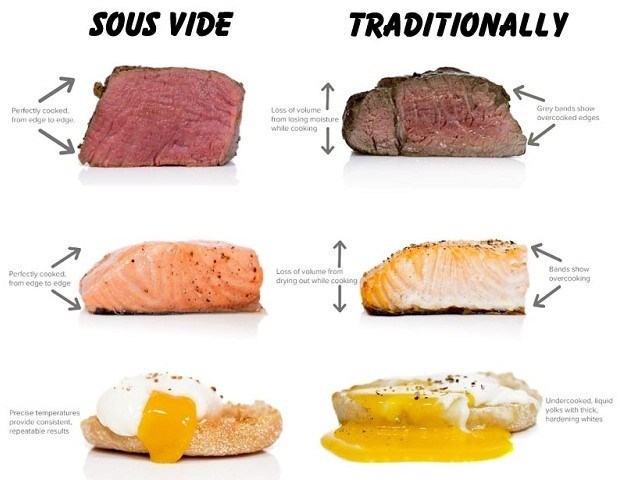Sous vide - Advanced technology to improve food qualitySous vide is known to be one of the cooking techniques proposed in 1799 by Benjamin Thompson, but it was not until 1960 that the technique was applied by Americans and French to food preservation. By 1974, chef Georges Pralus working at the Troisgros restaurant (Roanne, France) has carefully applied Sous vide to cook foie gras. As a result, the foie gras not only keeps the necessary texture, shape, and fatness, but also makes diners very satisfied. In recent years, this technique has been applied quite commonly to European dishes.
Sous vide in French means under vacuum, in food, Sous vide is a low temperature cooking technique – Raw materials are placed in a dedicated vacuum bag and cooked in water at low temperature. Quick or long cooking time depending on the type of food, can last up to 90 hours. After the food is cooked, if not used immediately, it will reduce the temperature below 3 ° C for 2 hours and store in the freezer. When needed, place the sous vide food vacuum bag into the pot of hot water to allow the food to reach the desired temperature.
- The advantages of applying Sous vide technique
Raw materials processed by Sous vide are located in a vacuum bag so the outside water cannot contact directly, helping to preserve the dissolved nutrients in the raw material. The cooking temperature is low, in an environment without oxygen, the freshness of the food - the aroma of the spices is retained, making the dish both nutritious and fresh.
For ingredients that are easily broken during cooking, if Sous vide is applied, it helps to retain the shape - the original texture of the dish, making the dish more beautiful when presented. Besides, because of cooking in a vacuum environment, food is guaranteed with hygienic safety criteria and has a longer shelf life.
For meat with a complex texture, sous vide is the ultimate cooking method. Under the action of a warm environment, the hard - complex connective tissue of meat will gradually turn into gelatin, making it easier to cook despite the prolonged cooking time. The finished dish will be softer, sweeter, not chewy due to dehydration like other conventional processing techniques.
    |
|
Figure 2. Difference between technical and traditional Sous vide variables (Internet source image)
 |
|
Figure 2. Difference between technical and traditional Sous vide variables (Internet source image)
|
Table 1. Heating mode recommends each material when applying Sous vide
|
Type
|
Temperature
|
Time
|
Thickness
|
|
1. Meat
|
Part
|
|
Pork
|
Bacon
|
182 °F/ 80 °C
|
24 - 48 min
|
|
|
Ribs
|
138 °F/ 59 °C
|
24 - 48 min
|
2,5 cm
|
|
Beef
|
Tenderloin
|
138 °F/ 59 °C
|
60 min
|
7,6 cm
|
|
Ribs – Long meat – Tenderloin
|
138 °F/ 59 °C
|
60 - 120 min
|
2,5 cm
|
|
Breast
|
147 °F/ 64 °C
|
48 h
|
|
|
Calf things
|
167 °F/ 75 °C
|
12 – 24 h
|
3,8 cm
|
|
Poultry
|
Chicken/ Duck breast
|
147 °F/ 64 °C
|
60 min
|
5 cm
|
|
Chicken things
|
152 °F/ 66,6 °C
|
90 min
|
5 cm
|
|
Duck liver
|
134 °F/ 56 °C
|
35 – 55 min
|
5 cm
|
|
Lamb
|
Tenderloin
|
141 °F/ 60,5 °C
|
90 min
|
3,8 cm
|
|
2. Seafood
|
|
Salmon
|
125 °F/ 52 °C
|
20 min
|
2,5 cm
|
|
Snow fish
|
140 °F/ 60 °C
|
20 min
|
2,5 cm
|
|
Flounder
|
140 °F/ 60 °C
|
20 min
|
2,5 cm
|
|
Shrimp
|
149 °F/ 65 °C
|
15 - 20 min
|
2,5 cm
|
|
Lobster
|
145 °F/ 63 °C
|
15 - 35 min
|
2,5 cm
|
|
Scallops
|
140 °F/ 60 °C
|
15 - 35 min
|
2,5 cm
|
|
3. Vegetables and others
|
|
Tubers (carrot, beetroot, potato …)
|
185 °F/ 85 °C
|
45 - 90 min
|
5 cm
|
|
Cut Tubers
|
185 °F/ 85 °C
|
20 – 30 min
|
2,5 cm
|
|
Onion, dry onion
|
185 °F/ 85 °C
|
90 min
|
5 cm
|
|
Cut corn
|
185 °F/ 85 °C
|
30 min
|
2,5 cm
|
|
Artichoke core
|
185 °F/ 85 °C
|
27 - 75 min
|
3,8 cm
|
|
Poached eggs
|
145 °F/ 63 °C
|
60 min
|
|
|
Crustard (Creeme Angiaise)
|
179 °F/ 82 °C
|
20 min
|
|
Currently, thanks to the development of science and technology, packaging vacuum equipment, temperature measuring devices, ... are available on the market at a reasonable price, hope the above information will help The readers can apply Sous vide techniques in cooking delicious and nutritious dishes but also ensuring food safety and hygiene, contributing to strengthening health and disease prevention.
Soure: https://www.hoteljob.vn/tin-tuc/sous-vide-la-gi-3-dieu-ve-sous-vide-dau-bep-can-biet